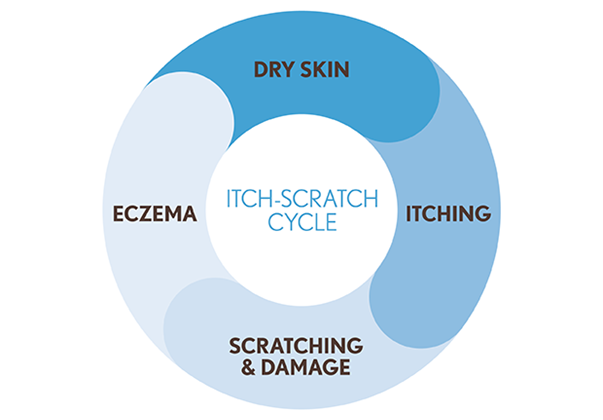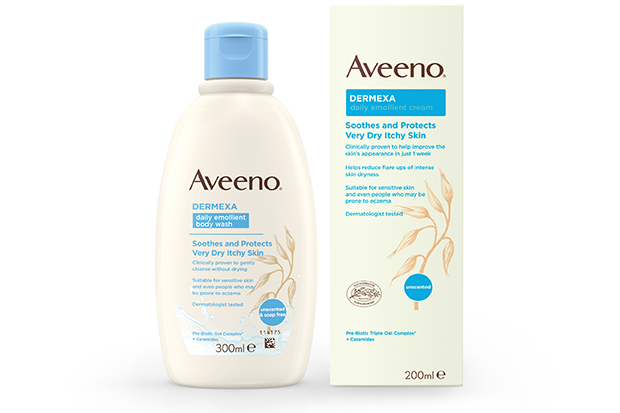What pharmacy staff need to know about dry and eczema prone skin
Dry vs eczema prone skin
Download the Identifying dry, itchy or ezcema prone skin poster here.
Normal to dry skin
Dry skin is most often caused by environmental factors such as cold temperatures and low humidity, but age, genetics and personal history of certain medical conditions can also play a role. When the skin loses too much of its vital water and oils it can become dry and look or feel rough, flaky and tight.1
Very dry, itchy and also eczema prone skin
The skin can be cracked, red and sore. It can affect any part of the body, but skin that may be eczema prone is often found on the hands, backs of the knees and inside of elbows.2 Eczema prone skin can be characterised by the ‘itch-scratch cycle’. When the skin becomes dry and irritated, it itches. Scratching triggers the release of a chemical called histamine, which causes more inflammation and itching, making the itch even worse. This is known as the ‘itchscratch cycle’.3
Managing dry and itchy eczema prone skin
Following current guidance, proper bathing and moisturising are essential for the daily care of very dry, itchy skin and skin that may be prone to eczema.2
What are emollients?
Emollients are moisturisers that help to regulate the skin, re-balance the skin microbiome and stimulate its natural defences. They work to reduce water loss and actively retain water within the skin barrier. A routine using a quality emollient can help your customers effectively manage their skin, keeping it healthy and hydrated.4 It is recommended that individuals with very dry, itchy and eczema prone skin use an emollient body wash and emollient cream frequently to help keep the skin barrier intact and prevent future flare-ups.4,5
How should emollients be applied?
The National Institute for health and Care Excellence (NICE) recommends that emollients are applied frequently and liberally, even when skin appears to be improved or clear – approximately 250-500g applied weekly.3 Emollients should be applied immediately after washing or bathing to maximise skin hydration. The skin should be gently dried before emollient application and applied in the direction of hair growth.4,5 If other topical treatments are to be applied, patients should be advised to wait 15-30 minutes after emollient application.5
Choosing the right emollient
Emollients can contain added ingredients, including:
- Ceramides – which can help to re-establish the balance of fats necessary for the appropriate functioning of the skin barrier.6
- Oatmeal – which has been found to have anti-itch properties.6
- Prebiotics – which have been shown to improve the skin’s barrier properties.7
Emollients with active ingredients such as urea, lauromacrogols, lanolin or lanolin derivatives or antiseptic are not generally recommended because they increase the risk of skin reactions.5
When to refer
Customers should be referred to their GP if:3,4
- The skin is severely cracked and oozing
- There is inflammation or infection
- There are signs of bleeding, weeping or crusting
- Constant scratching has caused the skin to split and bleed
- The customer complains of a lack of sleep due to symptoms
- Symptoms are impacting day-to-day aspects of life, including school, work and social activities.
References
- Dermnet NZ (2015) Dry skin.
- British Association of Dermatologists (2020) Atopic eczema.
- National Eczema Society (2018) Eczema and its management: A guide for healthcare professionals.
- NHS (2019) Atopic eczema.
- National Institute for health and Care Excellence (2018) Clinical Knowledge Summaries – Atopic eczema.
- National Eczema Society (2018) Emollient factsheet.
- Brosseau C, et al. Prebiotics: Mechanisms and preventive effects in allergy. Nutrients. 2019; 11(8):1841. Published 2019 Aug 8. doi:10.3390/nu11081841.
- Stamatas G, Joao Lopoes M, Volonakis K. Clinical evidence of the benefits of oats in children with atopic skin presentation slide 90, ESPD Congress May 2012.








